Learn about brain health and nootropics to boost brain function
Zapping One Brain Area May Selectively Improve Memory Recall


Researchers at UCLA have pinpointed a specific part of the prefrontal cortex that may be key for retrieving memories. One mild electrical "zap" to the left rostrolateral prefrontal cortex (RLPFC) using non-invasive transcranial direct current stimulation (tDCS) significantly improved episodic memory source retrieval performance in a recent study, they reported.
The researchers speculate that the left RLPFC plays a crucial role in cognitive functions that support episodic memory. These findings (Westphal et al., 2019) were published online ahead of print on May 6 in the Journal of Cognitive Neuroscience.
"We found dramatically improved memory performance when we increased the excitability of this region," the study's senior author, Jesse Rissman, a UCLA assistant professor of psychology, psychiatry and biobehavioral sciences, said in a press release. "The left rostrolateral prefrontal cortex is important for high-level thought, including monitoring and integrating information processed in other areas of the brain. We think this brain area is particularly important in accessing knowledge that you formed in the past and in making decisions about it."
Are There Different Non-Invasive Transcranial Brain Stimulation Techniques?
Multiple non-invasive transcranial stimulation techniques use weak, low-voltage electrical currents to zap targeted brain areas through the skull in controlled laboratory environments. (Note: Do not try this at home!) Some of the most widely studied methods of transcranial electrical stimulation (tES) include Transcranial Direct Current Stimulation (tDCS), Transcranial Alternating Current Stimulation (tACS), Transcranial Pulsed Current Stimulation (tPCS), and Transcranial Random Noise Stimulation (tRNS).
Another recent brain stimulation study (Herpich et al. 2019) found that just 10 days of visual training coupled with transcranial random noise stimulation (tRNS) targeting the visual cortex resulted in improvements in visual motion perception. (See "Brain Stimulation May Improve Visual Learning.")
How Does Zapping the Brain Using tDCS Improve Memory Recall?
Andrew Westphal was the lead author of this tDCS memory retrieval study targeting the left RLPFC as a doctoral student in the Rissman Memory Lab at UCLA. Currently, Westphal is a postdoctoral scholar in neurology at UCSF.
In a statement, Westphal described how non-invasive brain stimulation feels and works: "The technique, called tDCS, gives most people a warm, mild tingling sensation for the first few minutes. The stimulation is helping people to access memories that they might otherwise have reported as forgotten."
For this two-day study, 72 healthy adult participants were randomly divided into three experimental groups. On the first day, all of the study participants performed a memory encoding task. On the second day, participants were tested on their memory retrieval ability.
On day two, the hour-long "selective memory retrieval" assessment was divided into two 30-minute parts. During the first half hour, each study participant was tested on memory recall while receiving "sham" brain stimulation that gave a phony sensation of something electrical happening, but no stimulation was actually administered.
During the second half-hour of memory testing, only one of the three groups received tDCS electrical current stimulation to the RLPFC. The second group received an electrical current designed to suppress neuron activity, and the third group received sham stimulation again. Then, the researchers analyzed which group had the best memory recall from the previous day.

"The experimental group that received [electrical] tDCS to the left RLPFC during the second session demonstrated significantly improved episodic memory source retrieval performance, relative to both their first session performance and relative to performance changes observed in the other two experimental groups," the authors said.
"Our previous neuroimaging studies showed the left rostrolateral prefrontal cortex is highly engaged during memory retrieval," Rissman concluded. "Now the fact that people do better on this memory task when we excite this region with electrical stimulation provides causal evidence that it contributes to the act of memory retrieval."
In closing, Rissman emphasized that brain stimulation neuroscience is still in an early stage of development and warned against using commercially available methods of transcranial stimulation. He said: “If you do [tDCS] at home, you could stimulate your brain in a way that is unsafe, with too much current or for too long.”
Click here to view full article